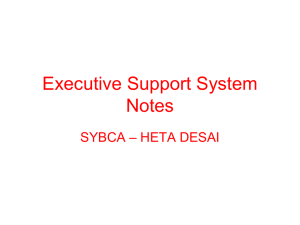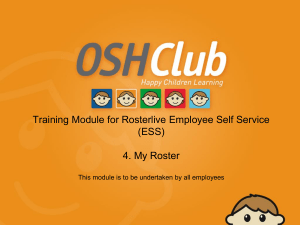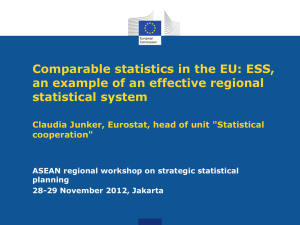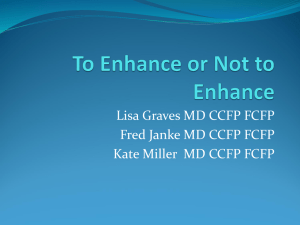How common are employee share schemes and how has the
advertisement
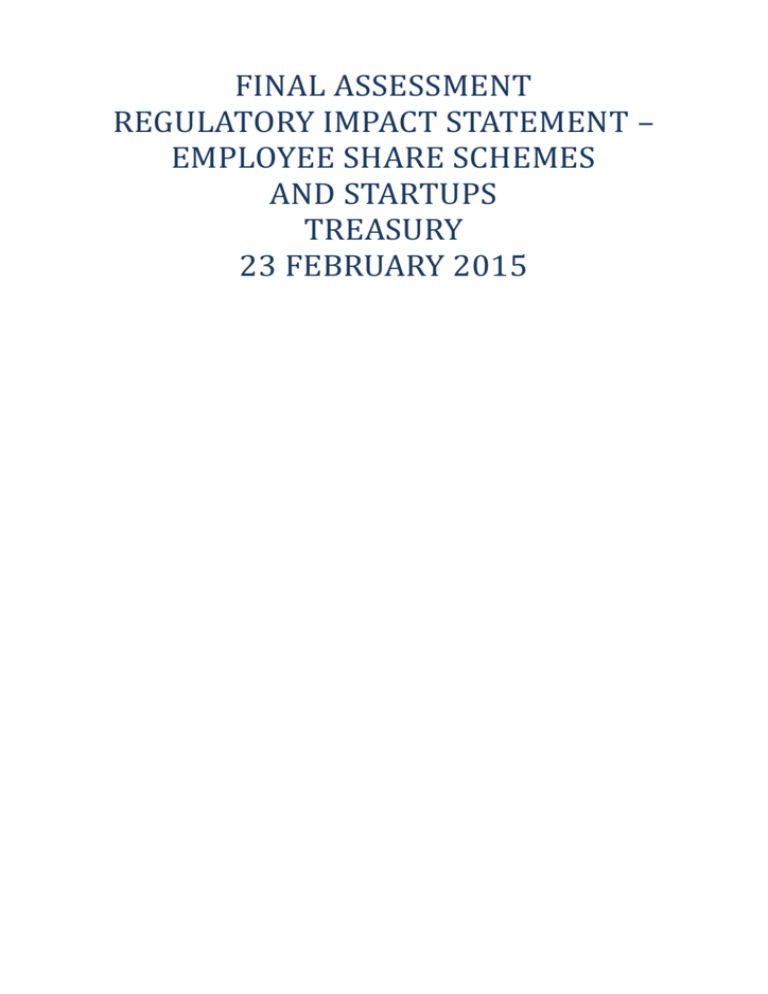
FINAL ASSESSMENT REGULATORY IMPACT STATEMENT – EMPLOYEE SHARE SCHEMES AND STARTUPS TREASURY 23 FEBRUARY 2015 Langton Crescent, PARK0, Australia P 02 6263 3740 F 02 6263 3360 www.sury.gov.a 2 Table of Contents INTRODUCTION ............................................................................................................................................. 3 CURRENT ARRANGEMENTS ........................................................................................................................... 3 QUESTION 1: WHAT IS THE PROBLEM YOU ARE TRYING TO SOLVE? ............................................................ 4 QUESTION 2: WHY IS GOVERNMENT ACTION NEEDED? ............................................................................... 6 QUESTION 3: WHAT POLICY OPTIONS ARE YOU CONSIDERING? .................................................................. 7 Option 1: Maintain the status quo [‘the do nothing option’] ................................................................... 7 Option 2: Remove the ESS tax concessions [‘the deregulatory option’] ................................................... 7 Option 3: Defer the taxing point for all companies, and address administrative concerns, while retaining existing integrity measures [‘the first regulatory option’] ......................................................... 8 Option 4: Provide the same four elements as Option 3, and add additional concessions for startups [‘the second regulatory option’].............................................................................................................. 11 Option 5: Provide direct funding to startups to reduce the cost of establishing ESSs [‘a non-regulatory option’] .................................................................................................................................................... 13 QUESTION 4: WHAT IS THE LIKELY NET BENEFIT OF EACH OPTION? .......................................................... 13 Option 1: Maintain the status quo .......................................................................................................... 13 Option 2: Remove the ESS tax concessions ............................................................................................. 13 Option 3: The first regulatory option ...................................................................................................... 14 Option 4: The second regulatory option ................................................................................................. 14 Option 5: Provide direct funding to startups to reduce the cost of establishing ESSs ............................ 15 Summary.................................................................................................................................................. 15 QUESTION 5: WHO WILL YOU CONSULT ABOUT THESE OPTIONS AND HOW WILL YOU CONSULT THEM?15 QUESTION 6: WHAT IS THE BEST OPTION FROM THOSE YOU HAVE CONSIDERED?................................... 17 QUESTION 7: HOW WILL YOU IMPLEMENT AND EVALUATE YOUR CHOSEN OPTION? .............................. 18 3 INTRODUCTION 1. Employee share schemes (ESSs) are schemes in which employers issue shares (an ownership stake in the company) and/or options (the right to acquire shares in the company at a later date) to their employees at a discount1 on the market value. Firms offer these because they see the benefits of improving the alignment of employee and employer interests, encouraging positive working relationships, boosting productivity through increased employee commitment to a company, reducing staff turnover and encouraging good corporate governance. 2. ESS arrangements can be particularly valuable for cash constrained startups, who often lack the cash flow to pay internationally competitive salaries to their employees. ESSs offer an option for attracting and retaining talented people with appropriate remuneration, while ensuring sufficient capital is available to allow growth of the startup. These schemes are often lucrative to employees, because they offer the employees with a financial share of the potential success of the company. As such, the Government provides a level of preferential tax and regulatory system benefits for ESS arrangements to stimulate their use. CURRENT ARRANGEMENTS 3. Under the current ESS system, Division 83A of the Income Tax Assessment Act 1997 (ITAA 1997) generally taxes any discount on the market value of an interest in shares or options provided to an employee under an ESS in the income year that it is acquired by the employee. 4. The tax treatment of an employee’s ESS interest differs when there is a real risk that the employee will forfeit eligibility for the shares or options. A real risk of forfeiture in a scheme may include conditions where retention of the ESS interests is subject to performance hurdles, or a minimum term of employment2. For example, if an employee is given an ESS interest by their employer, but the employee will lose those ESS interests if he/she leaves the company within five years, this could constitute a real risk of forfeiture. The same might be true if there is a performance hurdle that the employee must meet before being granted access to the ESS interests. 5. If there is no real risk that the employee will forfeit eligibility, discounts on ESS interests are taxable up-front to the employee. However, employees with adjusted taxable income of $180,000 or less are eligible for a tax exemption on the first $1,000 of discounts received each year on eligible ESS interests. If an eligible employee receives more than $1,000 of discounts in an income year, he/she will only be taxed on the discounts in excess of the first $1,000. 6. If there is a real risk of an employee forfeiting their discounted shares under the conditions of the ESS (or they are acquired through a salary sacrifice arrangement) then taxation is deferred until the earlier of: removal of the risk of forfeiture such that the scheme no longer genuinely restricts disposal of interests (for example, a minimum tenure of performance hurdle is met); cessation of employment; or seven years from acquisition of the interest. 1 The discount is generally taken to be the difference between the market value of the share or right and any amount paid by the employee to acquire the share or right. 2 The Australian Taxation Office provides guidance on the real risk of forfeiture test: http://ato.gov.au/General/Employee-shareschemes/In-detail/Restrictions-and-forfeiture/Real-risk-of-forfeiture/?default=&page=3#Real_risk_of_forfeiture_test . 4 7. In situations where the tax is paid and shares or options are subsequently genuinely forfeited, a tax refund is available. However, as the refund provisions are not intended to protect the employee from downside market risk3, a refund is not available where shares are forfeited only because the value has fallen due to market forces. For example, a refund will not be available in instances where an employee chooses not to exercise their ESS options purely because the share price of the firm is not high enough to make the ESS options valuable to them. Where the taxpayer is not eligible for a refund, the taxpayer would instead have a capital loss under the capital gains tax provisions. 8. In order for an ESS to qualify for the above tax treatment, the shares or options issued under the ESS arrangement must satisfy eligibility requirements. These requirements aim to ensure, among other things, that participation in the scheme is widely available to employees, and that the concessions cannot be accessed by shareholders who are effectively able to exert control over the company’s operations. 9. To be eligible: the ESS interests must not result in any one employee owning more than 5 per cent of the shareholding or controlling more than 5 per cent of the maximum voting rights; the scheme must be offered on a non-discriminatory basis to at least 75 per cent of Australian resident permanent employees with three years’ service; there cannot be a real risk of forfeiture; and the shares must be held for a minimum of three years or until the employee ceases employment. QUESTION 1: WHAT IS THE PROBLEM YOU ARE TRYING TO SOLVE? 10. The current taxation arrangements of ESSs arise from changes made in 2009 as part of the 2009-10 Budget. These changes include: removing the possibility for employees to elect when tax would be paid on the discount on options provided under an ESS, and as a result, taxing all discounts on shares and options in the income year in which the shares and options are acquired, unless there is a real risk of forfeiting the shares or options, or they are acquired through a salary sacrifice arrangement; capping concessional tax treatment for particular schemes as follows: if discounts are taxed up front, only employees with adjusted taxable income of $180,000 or less remained eligible for a tax concession on the first $1,000 of discounts received each year on eligible ESS interests (previously, there was no income limit on the concession); tax deferral in limited circumstances (where there is a real risk of an employee forfeiting their discounted shares under the conditions of the ESS or those that are acquired through a salary sacrifice arrangement) until the earlier of removal of the risk of forfeiture; cessation of employment; and seven years from acquisition of the interest; introducing an annual reporting requirement and associated withholding arrangements by companies that participate in these schemes. 3 That is, the financial risk associated with losses – or, the risk of a difference between the actual return and the expected return, where the actual return is less. 5 11. These changes were designed to more effectively target the tax concessions available for ESSs, bring the taxing point for ESS interests into line with the taxing point for other forms of remuneration and to minimise opportunities for tax avoidance and reduction. As part of this, there was a range of integrity measures introduced to address concerns of misapplication of the law and tax evasion in the ESS system (the ATO estimated that the pre-2009 ESS tax arrangements resulted in lost revenue of up to $100 million per year). 12. A post-implementation review of those arrangements was completed by the Treasury on 21 November 2013, which assessed that the ESS measure was broadly meeting its objectives. This largely related to the objectives of aligning the taxing point for ESS interests with that of other forms of remuneration and minimising opportunities for tax reduction through ESS. The review also noted that the introduction of new reporting requirements was meeting its objective of improving integrity. 13. With that said, the post-implementation review acknowledged that concerns had been raised that the changes to the tax treatment of ESSs made since the 2009-10 Budget may have a negative impact on some sectors of the economy. In particular, the following issues were identified as barriers to firms, particularly startups, wishing to utilise ESS arrangements: the taxation point for options; the amount of administrative burden required to establish and maintain an ESS; and the complexity of the valuation methodology for options. 14. As a result of those concerns, the former Government commenced consultation with industry on the most effective measures to address the barriers faced by startup companies. These consultations revealed that some of the problems were more pronounced than initially perceived. 15. Since the post-implementation review was completed in 2013, the current Government has indicated that addressing the issues outlined above is a priority. The Prime Minister announced on 18 December 2013 that the National Industry Investment and Competitiveness Agenda would consider, among other things, the current taxation arrangements for ESS. 16. The Government has continued consultations on this issue and their consultation process is referred to at various points in this Regulation Impact Statement, and outlined in further detail under Question 5: Who will you consult about these options and how will you consult them? below. There have been two main streams of concern that have arisen out of this current process. Firstly, many companies have argued that it is not reasonable to tax options until the employee takes action to realise or convert them to tradeable shares. Secondly, unlisted startups have argued that they face additional problems around both valuation and liquidity – as their shares are not listed, there are difficulties determining valuations cost effectively and there is not a ready market to enable liquidity to pay the tax. 17. Although the 2009 changes appear to have reduced the popularity of options issued under an ESS for all companies, the impact appears to have been felt more keenly by startups, which often lack the capacity to implement alternative ways to remunerate employees. This issue has been identified by both the former4 and current5 Governments as a key area for attention. Innovation is vital to Australia in order to improve living standards, create new business opportunities and be globally competitive. The development of a strong and innovative economy is an important ingredient in creating jobs and improving productivity. 4 5 Advancing Australia as a Digital Economy: An Update to the National Digital Economy Strategy, 12 June 2013 Securing Australia’s Manufacturing Future, 18 December 2013 6 18. Industry has indicated that the existing taxation arrangements are causing an increasing number of Australian startups to move overseas. This view has been put forward by a range of industry stakeholders over recent years. 19. Some ESS interests can also be unaffordable to the beneficiaries due to cash flow issues arising from the timing of the payment of tax. The current tax arrangements require tax to be paid in the income year in which options are effectively acquired, as opposed to the point of exercise or sale of the interest. Given that only a small proportion of startups will succeed, tax may be required to be paid on something that may never have a convertible or realised value to the employee. Stakeholders claim that these tax arrangements are inconsistent with global practice and this can result in talented employees choosing to work overseas instead of working in Australia.6 20. Once established, there are further costs involved in the ongoing operation and administration of an ESS, a key cost being that a company valuation is required when additional shares or options are issued under an ESS. Stakeholders have advised that this can cost as much as $50,000 per valuation in Australia, compared, for example, with the United States where the cost is US$2,000 to US$5,000. Stakeholders have also advised that multiple valuations can be required each year depending on when shares and options become taxable. This often makes an ESS unaffordable to many capital intensive startups as they seek to focus their capital on the growth of the company. Other operating and administrative costs, such as the documentation required to establish an ESS, were also identified in the consultation process as being problematic. HOW COMMON ARE EMPLOYEE SHARE SCHEMES AND HOW HAS THE PREVELANCE CHANGED OVER TIME? 21. ESS reporting requirements were introduced in 2009, which has resulted in a substantial increase in the amount of ESS data that is reported to the Australian Taxation Office (ATO). Prior to 2009, very limited information existed on the prevalence of ESS arrangements in Australia. 22. Even since the introduction of reporting requirements, there is limited information available on the amount and value of ESS interests issued in Australia. This is largely because there is no readily available data on the value of interests when they are granted to the employee. Reporting generally occurs when the employee receives ESS income (for example, the employee converts their options to shares and sells those shares). 23. Given that reporting requirements only began in 2009, the reporting system is still in its early stages – it will take some more time before we are able to compare data over time and extrapolate trends in ESS usage. 24. Having said that, there are some data available that offer an insight into the popularity of ESS in Australia. In 2011-12, around 34,500 employees reported deferred ESS income totalling $912 million7. This number includes income generated from both options and shares, and equates to approximately $26,500 per employee. The average benefit per employee has remained broadly consistent since the introduction of reporting requirements. 25. Since 2009, the number of employees reporting ESS income has increased significantly, which is probably due to the adoption of (and compliance with) reporting requirements by ESS users. A number of 6 It is worth noting that not all stakeholders were equally informed regarding current domestic or international arrangements relevant to the taxation of ESSs. 7 Taxation Statistics 2011-12 7 stakeholders, particularly in the startup community, have stated that the tax treatment of ESS in Australia since 2009 has contributed to firms moving offshore. There have also been claims that the 2009 changes effectively put an end to the provision of options under ESSs in Australia. These assertions have been put to government on a number of occasions, however there is no readily available data on to quantify these claims. QUESTION 2: WHY IS GOVERNMENT ACTION NEEDED? 26. The problems identified with the existing ESS taxation arrangements can only be addressed by changing the legislation to make the use of ESS more attractive and accessible, particularly for startups. 27. Making ESS more attractive and accessible for businesses and their employees would encourage a flourishing startup sector, which is an important element of ensuring Australia is a thriving hub for innovative industry. 28. International research suggests that companies in which employees have an ownership interest are more productive than those that do not. QUESTION 3: WHAT POLICY OPTIONS ARE YOU CONSIDERING? 29. There are two main aims for this proposal: For all companies, the aim is to ensure that they remain internationally competitive and reduce disincentives for employers and employees to participate in ESSs. For startups, the aim is to minimise complexity and compliance costs associated with the tax law, and increase the incentives for the startup sector to use ESSs. 30. In addition to ‘status quo’ and ‘deregulatory’ options, consultation has contributed towards the development of various options for reform. This process, commenced by the previous Government but taken forward under the current Government, has included the release of a discussion paper prior to the 2013 Federal election and a small number of submissions received in response to that paper. Further submissions were received from stakeholders in January and February 2014 under a new consultation process involving direct consultations with stakeholders and liaison with various Ministers, government agencies and departments. 31. This RIS examines five options. Option 1: Maintain the status quo [‘the do nothing option’] 32. Under option 1, no changes will be made to the legislative arrangements that govern ESS. That is, the status quo will be maintained. Option 2: Remove the ESS tax concessions [‘the deregulatory option’] 33. Under option 2, all concessions for ESS will be removed. One submission to the existing consultation process raised a similar suggestion, arguing that a diminishing number of companies are utilising the current ESS arrangements. The submission suggested that establishing alternative ‘workaround’ arrangements to avoid both the tax and regulatory imposts would deliver insignificant revenue while placing a burden on the economy. 8 34. Under this option, employers will not have to comply with the rules in Division 83A of the ITAA 1997. While the compliance cost savings for employers will be large, employers will not be able to access concessional income tax treatment for the shares and options that they provide to their employees. 35. In addition, ESS will also become subject to fringe benefits tax. Currently, where an ESS meets the requirements of Division 83A of the ITAA 1997, the legislation provides that it is not a fringe benefit and therefore not subject to fringe benefits tax. This is to avoid double taxation because ESS is taxed in the income tax system. However, if the tax treatment of ESS concessions was no longer covered under the income tax system, ESS would then be subject to fringe benefits tax. Any compliance savings to the employer from this would be lost and, in many cases, the ESS interest would be subject to a higher rate of tax than it is at present. 36. Furthermore, the environment external to the ESS arrangements, in which many of the existing ‘workaround’ arrangements operate, is also constantly evolving. Option 3: Defer the taxing point for all companies, and address administrative concerns, while retaining existing integrity measures [‘the first regulatory option’] 37. This option would apply to all companies and involves a number of elements which, in combination, would reduce or delay the tax burden faced by employees receiving interests in ESSs at a discount and would reduce the costs associated with establishing and maintaining ESSs. First element 38. The first element would reverse some of the changes to the taxing point for ESS interests made in 2009 (while retaining suitably adjusted reporting obligations to the ATO to maintain integrity)8. The exemption for the first $1,000 of assessable discount on shares taxed up front for employees with assessable income exceeding $180,000 could be retained. 39. This would see the taxing point for options be deferred to the earliest of: when the right is disposed of (other than by exercising it); when the employment in respect of which the right was acquired ceases; if the right is exercised, and the share acquired as a result has disposal restrictions attached to it or there are conditions that could result in the share being forfeited – the time when those restrictions or conditions expire; if the right is exercised and there is no such restriction or condition – the time when the right is exercised; or fifteen years after the right was acquired (currently seven years). 40. For shares, where there are no conditions that could lead to the shares being forfeited, the taxing point will continue to be the time of acquisition. 8 The changes in 2009-10 introduced increased reporting requirements to improve the integrity of the tax system. As a result, employers are currently required to report shares and rights acquired under an ESS both at issue and at an employee’s taxing point. 9 41. In other cases (if there are conditions that could lead to the shares being forfeited) the taxing point for shares is the earliest of: when the share is disposed of; the later of: the time when the disposal restrictions expire; and the time when relevant forfeiture conditions expire; when the employment in respect of which the share was acquired ceases; or fifteen years after the share was acquired (currently seven years). Second element 42. The second element would address the difficulties that companies (particularly startups) face in valuing options where the taxing point occurs prior to the existence of an objective market price. There are two components to this. 43. The first component would involve amendments to the existing ‘safe harbour’ valuation tables, to update the tables to reflect current market conditions. A ‘safe harbour’ method is one that is endorsed by the ATO for use in tax affairs. The existing safe harbour valuation tables (in Division 83A of the Income Tax Assessment Regulations 1997) are used to value unlisted options, to ensure that they reflect current market conditions. However, these tables have not been updated since the 1990s and are based on outdated estimates of dividend yield, risk-free interest rate and volatility of share prices. As the tables have become outdated, they are not widely used. Other things being equal, this change would generally reduce the amount of income tax employees would be obliged to pay on unlisted options that were acquired at a discount. 44. The second component would involve the ATO working with industry to develop a simple valuation method that will streamline the process of establishing an ESS. A simple valuation method means that valuations could be conducted in house; thus minimising the expense and difficulty incurred in seeking an independent valuation. ASIC will also be consulted given their oversight of disclosure documents that involve the offer of securities. Third element 45. The third element relates to existing disclosure requirements under the Corporations Act 2001, which have also been identified in consultation as a deterrent to startup companies looking to issue shares under an ESS. While not designed to address ESSs specifically, the Corporations Act provides relief from disclosure requirements for offers totalling not more than $2 million that result in securities being issued or transferred to no more than 20 investors, within a 12 month period. 46. In addition, ASIC Class Order 03/184 provides limited relief for unlisted bodies from the requirement to produce a disclosure document when offering options through an ESS. ASIC has consulted on a range of matters, including broadening the classes of financial products that may be offered, and expanding the categories of persons who can participate in an ESS which qualifies for relief. 47. On 31 October 2014, ASIC released a new regulatory guide (Regulatory Guide 49 Employee incentive schemes, Class Orders and related documents) and new class orders. These documents are designed to reduce the compliance and red tape burden on firms offering ESS arrangements and enhance the benefits to employers and employees participating in ESSs. 10 Fourth element 48. The fourth element of option 3 would be to retain the current employer reporting and withholding requirements that were introduced in 2009. Employer reporting ensures that the ATO has a source of data to cross match against individuals’ tax returns, while withholding allows tax to be collected that might otherwise not be. Fifth element 49. There is currently a ‘significant voting and ownership rights’ limitation that restricts employees with a significant ownership in their employer from accessing the ESS tax concessions. The current limitation means that ESS tax concessions are not available to individuals with more than a 5 per cent ownership or voting right in the company. This option would increase that limit to 10 per cent and, as an integrity measure, ensure that all interests in the employer are taken into account when applying the test. 50. Increasing the ownership limit to 10 per cent will allow more employees of companies, particularly in the early development stage, to access the ESS tax concessions. Firms in the early development stage are often very small and a 10 per cent interest can often translate to a relatively small investment. A 10 per cent interest is also consistent with international practice for a ‘portfolio interest’, which is a generally accepted benchmark for a passive investment that is part of a wider portfolio of investments, as opposed to an active investment where the investor may exert some influence over the operations of the company. Regulatory Cost 51. Table 1 shows the average annual regulatory costs for this option, ‘the first regulatory option’. The total compliance cost incurred by industry is estimated at $0.3 million per year, which is comprised of: the total set-up costs for existing ESS users of around $370,000, averaged (over ten years) at $37,000 per year; plus the total set-up costs for new ESS users of around $520,000, averaged (over ten years) at $52,000 per year; plus the total ongoing compliance costs for new ESS users of approximately $196,000 per year. 52. This is based on the assumption that firms currently offering an ESS would incur a one-off compliance cost (but no new ongoing costs) because of the new rules. This cost is based on an additional seven hours per firm spent on learning, communication, systems and record keeping. 53. It is estimated that new ESS users will incur a one-off start-up investment of 40 hours per firm (on average), spent preparing reports on ESS interests. It also assumes that reporting to the ATO and the employees of the business will take an average of 15 hours per firm (per year). 54. It is expected that updating the safe harbour valuation tables and the issuance of standard documents by the ATO will result in compliance cost savings. These compliance cost savings have not been calculated or included in this Regulation Impact Statement, as the details are yet to be agreed. These compliance costs will be considered once the policy and administrative details have been finalised. 55. A regulatory offset has been identified from within the Treasury portfolio. This offset relates to the Future of Financial Advice (FOFA) reforms. 11 TABLE 1: OPTION 3 REGULATORY BURDEN AND COST OFFSET ESTIMATE Average Annual Regulatory Costs (from Business as usual) Change in costs ($million) Business Community Organisations Individuals Total change in cost Total by Sector 0.29 - - 0.29 Cost offset ($million) Business Community Organisations Individuals Total by Source Agency 0.29 - - 0.29 Total by Sector 0.29 - - 0.29 Are all new costs offset? ☒yes, costs are offset (see below) ☐ no, costs are not offset ☐ deregulatory, no offsets required Total (Change in costs - Cost offset) ($million) 0 Option 4: Provide the same four elements as Option 3, and add additional concessions for startups [‘the second regulatory option’] 56. Industry has argued that the 2009 changes to the taxing point are out of step with global practice and that they put Australian companies at a disadvantage in attracting and retaining the staff they need. 57. In addition to the elements outlined under Option 3, this option would provide an additional concession exclusively to startups, along the lines of concessions currently operating in the United Kingdom, in order to improve the international competitiveness of Australia’s arrangements. 58. This option would allow eligible startups to issue options or shares at a small discount, and have the tax treatment of that discount deferred until disposal (for options) or exempt from tax (for shares). For options, any gains from the date of issue will be taxed under normal capital gains rules. 59. The amount of tax exempt discount able to be provided on options will be capped by requiring that the strike price of the option is greater than or equal to the market value of the underlying share on the date of issue (that is, the option is not ‘in the money’ when issued). Shares that are provided at a discount of no greater than 15 per cent will not be subject to income tax. 60. A key policy driver in providing such a concession would be to enhance the productivity of startups, by seeking to further align employer and employee interests through the use of ESSs. With this policy focus in mind, the concession could be restricted to unlisted companies with an aggregated turnover of no more than $50 million that has been incorporated for less than 10 years, as a proxy for defining a startup. 61. To ensure that the concession operates to further align interests and is not simply used as a vehicle to indefinitely defer the payment of tax, appropriate integrity arrangements could include 12 maximum limits on the amount of options and/or shares that an employee may hold in the company; exclusion of particular associates of directors or significant shareholders from participation in the scheme; ESS options and shares could be subjected to minimum holding periods of 3 years; and requirements could apply to employers to report on the number of ESS interests issued under this option. Regulatory Cost 62. Table 2 shows the average annual regulatory costs for this option, the ‘second regulatory option’. This option would result in the same compliance costs as option 3 plus the additional compliance costs associated with the small business concessions of $1.02 million. These additional compliance costs are comprised of: the total set-up costs of around $2.09 million, averaged (over ten years) at $209,000 per year; plus the total ongoing compliance costs of around $785,000 per year. 63. This is based on the assumption that preparing reports on ESS interests would be a one-off start-up cost involving an average of 40 hours per firm. It also assumes that reporting to the ATO and the employees of the business will take an additional 15 hours per firm (per year). 64. A regulatory offset has been identified from within the Treasury portfolio. This offset relates to the Future of Financial Advice (FOFA) reforms. 65. Options 3 and 4 combined have an estimated cost to revenue of $200 million over four years. 13 TABLE 2: OPTION 4 REGULATORY BURDEN AND COST OFFSET ESTIMATE Average Annual Regulatory Costs (from Business as usual) Change in costs ($million) Business Total by Sector 0.99 Community Organisations Individuals Total change in cost 0.99 Cost offset ($million) Business Community Organisations Individuals Total by Source Agency 0.99 - - 0.99 Total by Sector 0.99 - - 0.99 Are all new costs offset? ☒yes, costs are offset (see below) ☐ no, costs are not offset ☐ deregulatory, no offsets required Total (Change in costs - Cost offset) ($million) 0 Option 5: Provide direct funding to startups to reduce the cost of establishing ESSs [‘a non-regulatory option’] 66. A non-regulatory option may provide benefits to startups offering ESSs. One non-regulatory option that has been suggested is to provide funding to startups to assist them with the cost of setting up an ESS. This would provide direct benefits to startups but would not provide any direct benefits to employees of startups (or employees of larger companies). QUESTION 4: WHAT IS THE LIKELY NET BENEFIT OF EACH OPTION? Option 1: Maintain the status quo 67. A ‘do nothing’ option is to be considered in cases where problems may be self-corrected by market mechanisms. As the perceived problems are caused by existing legislative requirements, maintaining the status quo will not resolve the issues. Option 2: Remove the ESS tax concessions 68. Removing the existing ESS tax concessions would be likely to reduce the overall attractiveness of ESSs, which would be expected to lead to a decline in their use, removing some of the broad-based benefits associated with ESS. This may have impacts for the startup sector – some stakeholders claimed that this sector in particular relied upon ESSs to remunerate or reward their staff while ensuring capital could be retained for reinvestment in the business. As a result, many startup companies are likely to be discouraged from doing business in Australia and may be forced to look overseas for more favourable business conditions. The flow-on impact from this could be a material loss of innovative industry in Australia. Any regulatory savings achieved will likely be outweighed by new FBT compliance costs. 14 Option 3: The first regulatory option 69. The proposal to reverse, for all companies, key changes to the taxing point for options made in 2009 while retaining the integrity provisions would delay the taxing point for most employees and improve the attractiveness of participating in an ESS relating to options, including for employees of startups. This proposal would address the significant concerns raised by all companies during the consultations that the incentives for using ESSs in Australia are not strong enough. 70. This would provide an incentive for all existing firms to utilise ESS arrangements as a form of remuneration to their employees and could entice new firms into structuring in a way that allows them to benefit from the ESS tax concessions. This change would make Australia’s taxation of ESS options more competitive internationally and encourage more firms and employees to do business in Australia. There would be expected flow-on benefits from this, including job creation and increased employee productivity, company performance and innovation in the Australian economy. 71. This option is also attractive in that it would also avoid introducing into the law arbitrary boundaries to identify those eligible for changes to the taxing point. Many in the consultation process indicated that startups are difficult to define in a way that is useful in the tax law. In fact, a number of stakeholders (1 in 4 submissions) were resistant to the idea that any response be limited to just startups. 72. Retaining certain reporting requirements within this adjusted framework would minimise scope for losses to Commonwealth tax revenue through evasion or avoidance. Consultation revealed that many stakeholders (although admittedly not everyone) accept such reporting as a reasonable mechanism for tracking compliance with the law. 73. There are expected to be medium implementation compliance costs arising from this option. Businesses will need to learn about the changes. In particular, they may have to adhere to three different sets of rules to determine taxing points for options; these are the pre-2009 rules (for schemes established during that period and regulated by the arrangements relevant at that time), the 2009-2015 rules (for schemes set up under the existing ESS arrangements and regulated by those arrangements), and the post2015 rules (for schemes yet to be established under any new arrangements). 74. However, businesses and individuals who have schemes under more than one set of rules are expected to have systems in place and be familiar with the pre-2009 rules. They may also have to develop a communication strategy to inform their employees, and make changes to their systems to track the different taxing point. However, these companies will already have the foundations for ESS. 75. All ongoing impacts are expected to be minor. Individuals who are offered an ESS interest after the changes are introduced will need to learn about the changes and evaluate how they may be affected. Option 4: The second regulatory option 76. While option 3 would address the key concerns raised by all companies, there may be a need to provide additional concessions to startups in order to improve their competitiveness in an international context. 77. In relation to the proposed concession for startups, businesses will need to determine if they are eligible to qualify. Individuals will also need to learn about this change and determine if they work for an eligible startup. These changes are expected to have medium implementation compliance costs. 78. This option requires the formulation of a proxy to determine eligibility for the concessional tax treatment. This can be difficult to do in a simple and objective way, particularly given that there is no one agreed definition of a startup. It is important to note that using a simple and objective proxy is an 15 imperfect way to target eligibility however introducing additional tests and criteria to determine eligibility will often involve increased administrative and compliance costs, which are not desirable. 79. It has become clear that startups face additional challenges in accessing ESS arrangements and many have argued that they deserve additional concessions. The concessions under this option would provide an incentive for eligible firms to offer ESS to their employees and is expected to translate into a higher utilisation of ESS in Australia. This would allow employers to maintain more cash in the firm for the development of the business and provide employees with a financial interest in the success of the company. 80. This concession will make Australia’s tax arrangements for startup firms more competitive when compared with our major trading partners, and encourage both new and existing firms to develop business ideas domestically. The flow-on benefits from this concession could be substantial and result in a more innovative and productive Australian economy. Innovation is important in Australia to improve living standards and contribute to economic growth. 81. Ongoing compliance costs are expected to be low. Startups with an ESS will need to indicate via their reports to the Australian Taxation Office whether they are a startup. An individual with shares from an ESS and who is employed by an unlisted startup that utilises this concession may need to complete additional labels on the individual income tax return. Option 5: Provide direct funding to startups to reduce the cost of establishing ESSs 82. Providing funding to startups to implement ESSs would not address the cash flow problems that employees face in paying tax on discounts received before they are able to find the cash to pay that tax. This option would reduce the costs to startups of setting up an ESS but would not by itself increase the popularity of ESSs with their employees. This is because direct funding to startups does not change the taxing point, which is the key concern of these companies. 83. This proposal should not give rise to any additional compliance costs, as no changes in regulation would occur. Companies that chose to implement a new ESS, thus incurring additional costs of implementation and ongoing administration, would be provided with funding for their expenses incurred. However, their employees would continue to pay tax on their ESS interests in the year of acquisition (unless there is a real risk of forfeiture). Summary 84. For both options 3 and 4, the benefits to companies and their employees of more concessional tax treatment of ESSs are expected to outweigh additional compliance costs on businesses and employees flowing from those changes. Implementing options 3 and 4 would be expected to address the main concerns raised by stakeholders since the 2009 amendments, including the problematic taxing point for ESS options and the additional difficulties faced by startup companies. QUESTION 5: WHO WILL YOU CONSULT ABOUT THESE OPTIONS AND HOW WILL YOU CONSULT THEM? 85. The Government announced on 21 January 2014 that it would commence direct consultations with interested stakeholders in relation to the existing ESS arrangements for startups. 86. During these consultations, stakeholders expressed concern that the current arrangements for ESS in Australia are complex, costly and create a barrier or disincentive for many startups to set up an ESS; so much so that startup companies, like larger and more established corporations, often need to seek legal, financial and accounting advice to establish an ESS. 16 87. These arrangements put Australian startups at a competitive disadvantage in international markets, by making it harder for startups to attract and retain the skilled employees needed to grow the company (who generally tend to consider work opportunities offered within a global marketplace). 88. The purpose of stakeholder consultation on the taxation of ESSs, which was undertaken in January and February 2014 (and referred to earlier in this RIS), was to better understand the impacts of the current rules for ESSs on startups. An open invitation was placed on the Treasury website inviting stakeholders to nominate to participate in that consultation process9, meaning that consultation was not necessarily restricted to the startup community. This invitation was subsequently forwarded to known stakeholders, both from the startup and tax advising community. 89. Face-to-face and teleconference roundtable meetings were held with around 90 individual stakeholders in total. There were 57 submissions received from stakeholders, in addition to the 18 submissions that had been received in response to the previous government’s discussion paper. The key issues identified in that consultation process have been noted earlier, under Question 1: What is the problem you are trying to solve? 90. There is consensus from submissions that the current tax rules impede the use of ESS in Australia and that this provides a deterrent to attracting and retaining the internationally-mobile staff that they need to grow their business, with flow-on impacts for decisions to commence and retain operations in Australia; that the costs of setting up ESSs for startups are very high and that any solutions adopted should therefore seek to minimise costs and keep complexity to a minimum; and that it is expensive and conceptually difficult to determine the market value of startups (or unlisted companies more generally) for the purpose of valuing employees’ interests in ESSs. However, there was no consensus about a range of matters, including those most deserving of assistance or concessions, and any method for identifying such a group. 91. On 14 October 2014, as part of the Industry Innovation and Competitiveness Agenda, the Government announced that it will improve the taxation arrangements for ESS, to make Australia’s tax system more competitive by international standards and allow innovative Australian firms to attract and retain high-quality employees in the international labour market. 92. Firstly, employees (of all companies) who are issued with options will generally be able to defer tax until they exercise the options (convert the options to shares), rather than having to pay tax when they receive the options. 93. Secondly, eligible startups will be able to issue options or shares to their employees at a small discount, and have that discount exempt (for shares) or further deferred (for options) from tax. Criteria will be applied to define eligible startups, including turnover of not more than $50 million, being unlisted and being incorporated for less than 10 years. There will also be a minimum three-year holding period for employees to be eligible for this concession. 94. The Government’s policy also includes increasing the maximum time for tax deferral (for tax deferred ESS interests) from 7 years to 15 years and doubling the maximum individual ownership limit from 5 per cent to 10 per cent of a company. 95. Since the announcement, Treasury has met with industry stakeholders on a range of issues. In general, the announcement has been well received by industry, who have been aware of the problems with the tax arrangements of ESS for some years now. There have been some concerns, mainly around the 9 See Treasury website: http://www.treasury.gov.au/ConsultationsandReviews/Consultations/2014/Employee-Share-Schemes-andStartups 17 eligibility conditions for the startup concession. The eligibility criteria were chosen to provide targeted assistance to startups, while avoiding complexity and not opening it up to all companies, which would come at a significant cost to Government revenue. 96. Draft legislation, regulations and explanatory material to enact the Government’s announced amendments were released and consultations were held on this material. As part of the consultation process, Treasury and the ATO held a series of targeted consultation meetings with industry stakeholders to ensure that the draft legislative materials achieve the policy intent of the Government’s announced policy. 97. The consultation meetings indicated that the draft legislation is on track to deliver the Government’s announced policy. That said, there were a number of policy issues raised, with some stakeholders seeking Government decisions to extend the eligibility for the startup concession to capture biotech and other companies that don’t meet the eligibility criteria. Some stakeholders believe that the concession should not exclude listed companies or firms that have been incorporated for more than 10 years. In addition to this, some stakeholders sought additional concessions for employees engaged in ESS arrangements. However, these policy issues would likely come at an additional cost to Government revenue, which may be difficult to achieve in the current budget environment. 98. In consultations, stakeholders sought to clarify some operational aspects of the legislation that may have resulted in unintended consequences. These queries related to the 50 per cent capital gains tax (CGT) discount for assets held for more than 12 months and the application of the eligibility criteria (for the startup concession) to investments by venture capital funds. Following these queries, the Government has clarified that: the 50 per cent CGT discount will generally be available to options issued under the startup concession where the options have been held for at least 12 months but the resulting shares are sold within 12 months of exercise; and certain investments by venture capital funds in startups will be excluded from the aggregate turnover and other grouping tests when determining eligibility for the startup concession. 99. Treasury has been involved in discussions with the ATO and ASIC in relation to the development of standard documents and the updating of the safe harbour valuation tables. The ATO are running separate consultations with industry to develop standard documents and update the safe harbour valuations. 100. The compliance cost estimates that were presented in the early assessment regulation impact statement (RIS) have been updated to reflect a change in methodology by the Office of Best Practice Regulation (OBPR). OBPR have advised that a new hourly labour rate should be used, which slightly decreased the compliance cost estimates of this proposal. No further changes were made to the compliance cost estimates. The information and assumptions used in estimating the compliance costs are still up-to-date. The consultations that have occurred since the release of the early assessment RIS provided the opportunity for stakeholders to comment on the compliance cost estimates, however no issues were raised with these figures. 101. The early assessment RIS was finalised following the Government’s announcement in October 2014, and uploaded onto OBPR’s website on 15 January 2015. QUESTION 6: WHAT IS THE BEST OPTION FROM THOSE YOU HAVE CONSIDERED? 102. Consultation made it very clear that there was no one agreed view regarding how to define the target group for which any additional assistance or concessions could be provided. Further, it became clear 18 that it was unlikely that any one single policy response would address all identified concerns. Indeed, even startup companies themselves, at different stages of development, did not necessarily agree a single outcome. 103. However, there was a very strong view put that the 2009-10 changes to taxing points for ESS interests had impacted on the decisions of parties to offer ESSs (particularly those relating to options) to their employees. 104. Options 3 and 4 are the preferred options as they address the majority of concerns raised by stakeholders. The sum of these two options is the Government’s announced policy. Notably, this policy would address the problematic taxing point for options for all companies. For eligible startups, an additional concession will be offered, which will assist them in developing their businesses in Australia. 105. While there have been some concerns raised by stakeholders in relation to the Government’s announced policy, most of the suggested amendments would come at a further cost to revenue. In the current Budget environment, it would be difficult to provide additional concessions, given the associated cost to Government revenue. 106. ESS tax concessions are designed to promote the use of ESS because of the positive benefits that can arise out of ESS arrangements. Many of these benefits arise as a result of the alignment of interests between employees and their employer. ESS tax concessions should be designed to complement other forms of targeted government assistance —small businesses and entrepreneurs also receive other forms of government assistance including the Entrepreneurs Infrastructure Programme, the R&D tax concession and the small business CGT exemption. QUESTION 7: HOW WILL YOU IMPLEMENT AND EVALUATE YOUR CHOSEN OPTION? 107. The legislation to implement the Government’s announced policy will be considered in light of feedback from the consultation process. 108. Some stakeholders have put forward very strong views that early commencement of policy options is desirable, however others have suggested that a delayed start date would be acceptable if it would result in a better policy outcome. 109. The Government intends to bring the changes into effect for shares and options issued from 1 July 2015. To facilitate this timeline, the legislation is currently scheduled to be introduced into Parliament in the autumn sitting of 2015. 110. The ATO are working to develop and approve standardised documentation for use by companies to reduce the amount of ‘red tape’ and streamline the establishment and administration of ESSs. 111. The effectiveness of the selected proposal in meeting the objective of increasing growth in the startup sector will be measured by the change in take-up of ESSs among small to medium sized business entities (SME) over the coming years. This proposal may also lead to an increased number of SMEs. Such metrics could be examined in a subsequent review. It is proposed to undertake such a review of the new arrangements after five years from the date of commencement of the legislation, to examine whether the arrangements have achieved their objectives. In addition to considering those objectives, this could also include examination of the extent to which the legislation: gives effect to the Government’s policy intent, with compliance and administrative costs commensurate with those foreshadowed in the Regulation Impact Statement for this proposal; is expressed in a clear, simple, comprehensible and workable manner; 19 avoids unintended consequences of a substantive nature; takes account of actual taxpayer circumstances and commercial practices; is consistent with other tax legislation; and provides certainty. 112. Industry feedback on these amendments will be a good barometer of the success of the policy, particularly in relation to the measures that the ATO are progressing to streamline the process of establishing and maintaining an ESS.

